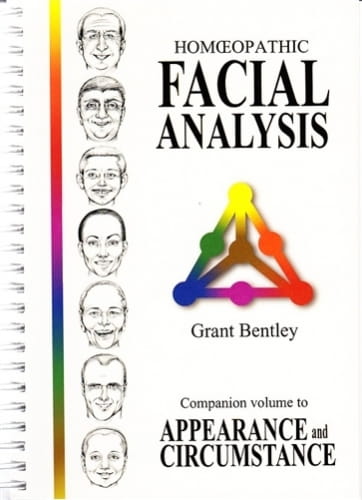Companion Volume to 'Appearance and Circumstance'
Homoeopathic Facial Analysis is a desktop guide on how to analyse facial features with hundreds of sketches detailing features. It is a complement to Bentley's previous book Appearance and Circumstance.
Homoeopathic Facial Analysis uses hundreds of illustrations to define the impact of psora, sycosis and syphilis on facial features. Many prominent homoeopaths such as J H Allen, Roberts and Foubister recognised that miasms meld facial structure and used certain facial features as indicators.
Homoeopathic Facial Analysis completes these earlier endeavours with structure and detail unparalleled by any other work in this field. More than seven years of research together with thousands of patients form the foundation for this new approach to prescribing with Hahnemann's miasms. Each feature has been tested and has proved its validity in numerous successful cases. Homoeopathic Facial Analysis is specifically designed for desktop. It is indexed, page-tabbed and spiral bound for easy reference and convenient use.
- Author: Grant Bentley
- ISBN: 9780646463230
- 162 pages
- Spiral Bound
- Published in 2006
- Printed in Australia
Reprinted with the permission of The Society of Homeopaths (from "The Homeopath" Journal, Summer 2009). This review is for the set of two books by Grant Bentley, 'Appearance and Circumstance' and 'Homeopathic Facial Analysis'. Reviewed by Petra Wood.
These two books are all about faces and miasms. The author, Grant Bentley, principal of the Victoria College of Classical Homoeopathy in Australia, developed the system of homeopathic facial analysis (HFA) from his studies of miasms and their influence on every part of the human being. "Miasms exert their influence just as comprehensively on the outside as they do on the inside." Consequently, facial features, more easily and unobtrusively observed than other physical features, must provide information about the underlying miasmatic state of the person. He builds on classical authors like Allen, Roberts and Foubister when explaining that HFA is not a completely new concept. But he is also keen to point out that HFA does not provide information about a person's character, as physiognomy would do, nor is it restricted through ethnicity or race.
The first book is the textbook with the necessary philosophy and a discussion of different theories about miasms: there are provocative conclusions, some of which form the basis of HFA. For example: "every person throughout his or her life is under the influence of only one miasm, without the possibility of change". Miasms are always to be regarded as something negative: "They do not contribute anything of positive value".
The number of miasms has to be restricted to three basic miasms (psora, sycosis and syphilis) with four other miasms being a mix of these three: psora-sycotic, sycotic-syphilitic and psora-syphilitic (which is tubercular), as well as the cancer miasm as a mix of all three basic miasms. Bentley then introduces a way of colour coding: three primary colours for the basic miasms, three secondary colours and brown as a mix of all - cancer. The primary colours were chosen to suit the temperament of each miasm. Bentley then deliberately stops using the familiar homeopathic terms for the miasms and refers to them as colours only. This is followed by detailed descriptions of themes of the different miasms, not necessarily following previous authors. The theme of 'lack' for example is absent in the description of the psoric miasm.
In the third part of the book the recognition of different facial features is applied to photographs. Any facial feature belongs to one of the three basic miasms, e.g. close-set eyes are psoric, large eyes sycotic and deep-set eyes syphilitic. Simply adding up the ratings for all features then provides the final choice of miasm, with mixed miasms being indicated when there is no clear dominance of any of the basic miasms.
The book has a two-page list of remedies, which, according to Bentley, have been confirmed from cured cases. This list has been expanded and its updated version can be accessed on www.vcch.org. There are less than 150 remedies classified into the miasms as defined by Bentley, most of them polychrests. Again, Bentley's work is different, as some of these remedies are not necessary classed where you would expect them to be, e.g., Pulsatilla is psoric and Silica in the cancer miasm. It is a thorough and stimulating read, well written in an easy style.
The second book is a revised and advanced reference book to the third part of Appearance and Circumstance, with illustrations and photographs. These give clear guidelines as to angles etc., for example to define a sloped forehead. This book is not meant to be read alone and does not provide any theory of HFA.
At www.soulandsurvival.com Bentley offers an online facial analysis 'wizard' where anyone may enter their own (or their patient's) details according to examples given. At the end of several pages of choice of shapes and features, the result is given simply as the colour group deemed appropriate. No ratings are available of how dominant is any miasm.
The idea of HFA is intriguing and readers will be looking at faces with renewed curiosity. It appears that the author has had great successes in his prescriptions following HFA. How much this success can be replicated remains to be seen. I hesitate to whole-heartedly follow a system that in its ways appears quite restrictive and categorised. Bentley acknowledges the risk involved in standardisation. He stresses that HFA refines our classical homeopathic methods but does not replace them. But he also insists that the facial features and the corresponding miasmatic category should always be the deciding factor in remedy choice.

